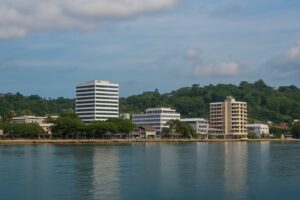Battle for the Palms: Vanuatu’s Crusade Against the Coconut Rhinoceros Beetle Menace
The presence of the coconut rhinoceres beetle (CRB) in Vanuatu has emerged as a significant agricultural challenge. First detected on Efate island in 2019, this pest, originating from Southeast Asia, has since become a grave threat to the nation’s coconut trees, undermining both the economy and food security.
This invasive species is part of the CRB-S group (Clade II), akin to those in the Bismarck Archipelago of Papua New Guinea. A more alarming development occurred in 2021 with the detection of the CRB-G group (Clade I^A^), thereby intensifying the complexities in controlling the infestation.
Despite concerted containment efforts by the government, the beetle has made its way to Santo Island, inflicting considerable harm. It’s implicated in the troubling decline of coconut yields, thereby affecting local livelihoods and the wider economic framework.
The CRB inflicts damage by burrowing into the crowns of coconut trees to feed on their sap, while its larvae destroy the palm fronds. This not only weakens the trees but also increases their vulnerability to diseases and other pests.
The beetle’s rapid geographical spread is attributed to the movement of contaminated plant debris, soil, and equipment, with infested coconut logs, often utilized in local construction, posing a particular risk. Furthermore, the beetle’s capacity for flight boosts its ability to colonize new areas.
Efforts to contain the beetle have been stymied by a mix of technical and bureaucratic hurdles. On Santo Island, for instance, government initiatives have yet to effectively curb the CRB spread due to the beetle’s mobility and the movement of contaminated materials.
First identified in Guam during the 1940s, the CRB has long plagued the Pacific region, including a significant presence in Samoa for over a century. Its rapid reproduction rate and resistance to traditional biological controls, such as the Oryctes rhinoceros nudivirus, have compounded eradication attempts.
Nevertheless, there are budding signs of progress. Research into pheromone traps has shown promising results in curbing CRB populations elsewhere. These traps, baited with pheromones specific to the beetle, could potentially form a cornerstone of more effective control strategies.
Moreover, stringent biosecurity measures, including thorough inspections of plant material and equipment, are critical to forestall further dispersal of this pest. The government has been proactive in implementing these protocols to safeguard additional islands within the nation.
As the coconut rhinoceros beetle continues to jeopardize Vanuatu’s coconut industry and economic stability, the use of innovative measures such as pheromone traps alongside rigorous biosecurity practices will be pivotal in managing and hopefully overcoming this pestilence.
Sources:










